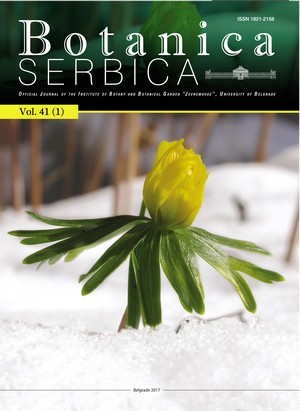
Volume 41 Issue 1 2017 |
Fatty acid composition of the cypselae of two endemic Centaurea species (Asteraceae)
|
KEY WORDS: fatty acids, Centaurea, Arenariae, Compositae, chemotaxonomy |
Effect of ABA treatment on activities of antioxidativeenzymes in selected bryophyte species
|
KEY WORDS: mosses, liverworts, abscisic acid, peroxidase, superoxide dismutase, catalase |
Protective effects of polyamines against UV-A and UV-B illumination in Physcia semipinnata Thalli
|
KEY WORDS: RAPD-PCR, putrescine, spermidine, spermine, lipid peroxidation |
Antioxidant response of the invasive alien species Parthenium hysterophorus L. under abiotic stress conditions with special emphasis on boiling-stable antioxidant enzymes
|
KEY WORDS: Parthenium hysterophorus, oxidative stress, ascorbate, glutathione, antioxidant enzymes, boilingstable proteins |
Effects of exogenous application of nano particles and compatible organic solutes on sunflower (Helianthus annuus L.)
|
KEY WORDS: compatible solutes, nano silicon dioxide, oil content, terminal drought stress, TiO2 nanoparticles |
Evaluation of microbial diversity of the microbial mat from the extremely acidic Lake Robule (Bor, Serbia)
|
KEY WORDS: Lake Robule, acidic environment, microbial mat, acidophiles, metagenomic analysis, T-RFLP |
First record of Paralemanea torulosa (Roth) Sheath & A.R. Sherwood and new findings of Lemanea fluviatilis (Linnaeus) C. Ag. and Hildenbrandia rivularis (Liebmann) J. Agardh (Rhodophyta) in Serbia
|
KEY WORDS: Hildenbrandia, Lemanea, Paralemanea, Rhodophyta, algae, Serbia |
New data on distribution and ecology of Batrachospermum (Rhodophyta) in Serbia
|
KEY WORDS: distribution, ecology, Batrachospermum, Rhodophyta, Serbia |
Hierochloë repens (Host) Simonk. (Gramineae) in Serbia
|
KEY WORDS: flora, chorology, Serbia |
Refinding of the critically endangered species Eranthis hyemalis (L.) Salisb. in Western and Eastern Serbia
|
KEY WORDS: Eranthis hyemalis, critically endangered, distribution, Serbia |
Dysphania pumilio (R. Br.) Mosyakin & Clemants (Amaranthaceae), a new allochthonous species in the flora of Serbia
|
KEY WORDS: allochthonous species, Amaranthaceae, Dysphania pumilio, Serbia |
Eclipta prostrata (L.) L. (Compositae), an adventive species new to the flora of Serbia
|
KEY WORDS: flora, chorology, neophytes, Serbia |
Euphorbia prostrata Aiton (Euphorbiaceae) – an adventive species new in Serbia
|
KEY WORDS: Euphorbia prostrata, Euphorbiaceae, new records, adventive species, Serbia |
Contribution to knowledge of the flora of the Republic of Macedonia
|
KEY WORDS: flora, first report, chorological data, Macedonia |
Acknowledgement of indebtedness to referees
|


